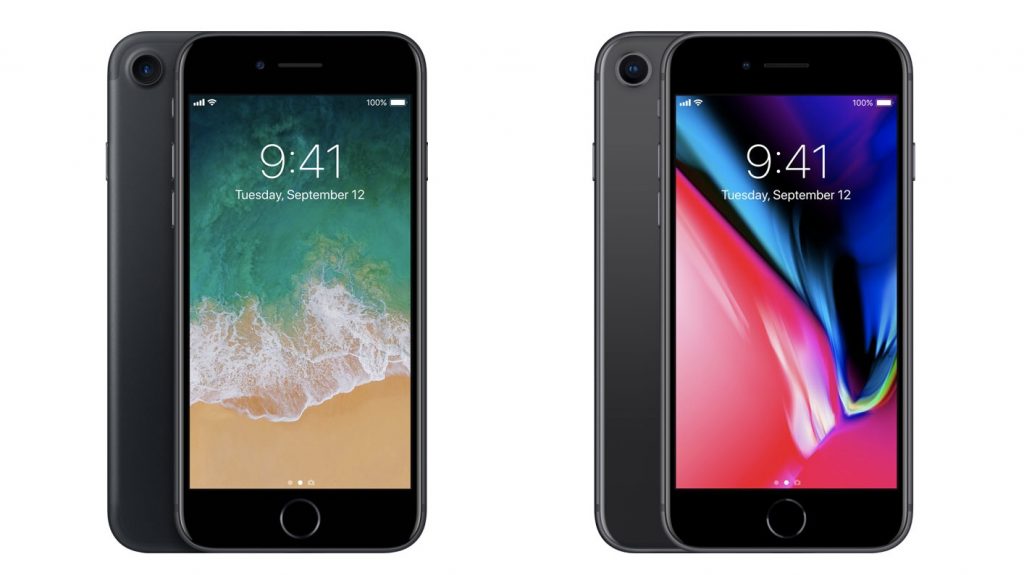Which is better, iPhone 7 or the iPhone 8? If you want an iPhone for the absolute basics, or just want to keep things as cheap as possible, consider the iPhone 8 which is running the latest version of iOS. But if the main goal is finding a small phone, or a phone with a home button and Touch ID — we recommend you look towards the newer 2nd or 3rd-generation iPhone SE.
If you’re a bargain shopper looking for a cheap iPhone, but can’t decide if you should buy the iPhone 7 or iPhone 8 in 2022 — Swappa is here to help. In this post, we’ll compare the iPhone 7 and iPhone 8, going over all the differences in features and prices. By the end, you should be in a better place to decide whether the iPhone 7 or the iPhone 8 is best for you. Or, if you should go another route entirely and look towards the newer iPhone SE (2020) or the iPhone SE (2022).
Difference between iPhone 7 and iPhone 8
The iPhone 7 was released in September 2016, and while the phone is lacking in terms of features, the iPhone 7 is still able to run a fairly recent iOS release — iOS 15 (the current as of October 2022 is iOS 16). However, there have been plenty of newer generation iPhones since then.
In 2017, Apple unveiled the iPhone 8, iPhone 8 Plus, and iPhone X — the most feature-packed and expensive iPhones at the time. A follow-up to the previous year’s iPhone 7 and iPhone 7 Plus, the iPhone 8 and 8 Plus would eventually be replaced by the iPhone XR, iPhone XS, and the iPhone XS Max — as well as several newer generations, such as the 13th generation, which includes the iPhone 11 and was released in September 2019.
If you want an iPhone for the absolute basics, or just want to keep things as cheap as possible, consider the iPhone 8 which is running the latest version of iOS. But if the main goal is finding a small phone, or a phone with a home button and Touch ID — we recommend you look towards the newer 2nd or 3rd-generation iPhone SE.
Spec Comparison: iPhone 7 vs iPhone 8 vs iPhone SE (2020) vs iPhone SE (2022)
| iPhone 7 | iPhone 8 | iPhone SE (2020) | iPhone SE (2022) | |
|---|---|---|---|---|
| Display | 4.7-inch Retina HD display (1334 x 750) | 4.7-inch Retina HD display with True Tone (1334 x 750) | 4.7-inch Retina HD display with True Tone (1334 x 750) | 4.7-inch Retina HD display with True Tone (1334 x 750) |
| Rear camera | Single 12MP, f/1.8, OIS | Single 12MP, f/1.8, OIS | Single 12MP, f/1.8, OIS | Single 12MP, f/1.8, OIS |
| Front camera | 7MP FaceTime HD, f/2.2 | 7MP FaceTime HD, f/2.2 | 7MP FaceTime HD, f/2.2 | 7MP FaceTime HD, f/2.2 |
| Connectivity | 4G LTE | 4G LTE | 4G LTE | 5G |
| Processor | A10 Fusion | A11 Bionic | A13 Bionic | A15 Bionic |
| RAM | 2GB | 2GB | 3GB | 4GB |
| Storage | 32GB, 128GB, 256GB | 64GB, 128GB, 256GB | 64GB, 128GB, 256GB | 64GB, 128GB, 256GB |
| Battery | 1,960 mAh | 1,821 mAh | 1,821 mAh | 2,018 mAh |
| Charging | Lightning | Lightning, Qi wireless, and Fast-charge capable (up to 50% in 30 minutes with 20W adapter) | Lightning, Qi wireless, and Fast-charge capable (up to 50% in 30 minutes with 20W adapter) | Lightning, Qi wireless, and Fast-charge capable (up to 50% in 30 minutes with 20W adapter) |
| Security | Touch ID fingerprint sensor | Touch ID fingerprint sensor | Touch ID fingerprint sensor | Touch ID fingerprint sensor |
| Water resistance | IP67 | IP67 | IP67 | IP67 |
| Size (dimensions) | 5.44″ (H) x 2.64″ (W) x 0.28″ (D) | 5.45″ (H) x 2.65″ (W) x 0.29″ (D) | 5.45″ (H) x 2.65″ (W) x 0.29″ (D) | 5.45″ (H) x 2.65″ (W) x 0.29″ (D) |
| Weight | 4.87 ounces | 5.22 ounces | 5.22 ounces | 5.09 ounces |
| Colors | Black, Silver, Gold, Rose Gold | Black, Silver, Gold | Black, White, PRODUCT(RED) | Midnight, Starlight, PRODUCT(RED) |
| Software | iOS 15 | iOS 16 | iOS 16 | iOS 16 |
Read more: Swappa’s Apple iPhone guides and comparisons
Price Comparison: iPhone 7 vs 8 vs SE (2020) vs SE (2022)
Now that you have a better idea of how each of these devices compares to each other in terms of hardware specs, you’re in a much better position to decide whether those “upgrades” are worth the hit to your wallet. Of course, another of the key differences between the iPhone 7, iPhone 8, iPhone SE (2020), and the iPhone SE (2022) is the price.
| Used iPhone 7 prices | Unlocked | Verizon | AT&T | T-Mobile |
|---|---|---|---|---|
| iPhone 7 (32GB) | $84+ | $69+ | $80+ | $70+ |
| iPhone 7 (128GB) | $84+ | $94+ | $83+ | $84+ |
| iPhone 7 (256GB) | $129+ | $129+ | $113+ | $129+ |
| Used iPhone 8 prices | Unlocked | Verizon | AT&T | T-Mobile |
|---|---|---|---|---|
| iPhone 8 (64GB) | $95+ | $95+ | $95+ | $95+ |
| iPhone 8 (128GB) | $122+ | $113+ | $156+ | $158+ |
| iPhone 8 (256GB) | $134+ | $178+ | $131+ | $178+ |
| Used iPhone SE (2020) prices | Unlocked | Verizon | AT&T | T-Mobile |
|---|---|---|---|---|
| iPhone SE (2020) (64GB) | $133+ | $129+ | $133+ | $130+ |
| iPhone SE (2020) (128GB) | $148+ | $148+ | $148+ | $148+ |
| iPhone SE (2020)(256GB) | $180+ | $180+ | $149+ | $174+ |
| Used iPhone SE (2022) prices | Unlocked | Verizon | AT&T | T-Mobile |
|---|---|---|---|---|
| iPhone SE (2022) (64GB) | $258+ | $340+ | $340+ | $171+ |
| iPhone SE (2022) (128GB) | $349+ | $349+ | $349+ | $271+ |
| iPhone SE (2022) (256GB) | $382+ | $382+ | $382+ | $382+ |
Shop safer and smarter with Swappa ♻️
Whichever iPhone you finally decide to pick up, Swappa is the perfect place to find a cheap iPhone. With a huge selection of gently used iPhones, Swappa will ease both your mind (and your wallet) whenever it comes time to upgrade your old phone. You can browse pricing and shop our entire selection of cheap iPhones using the button below.






